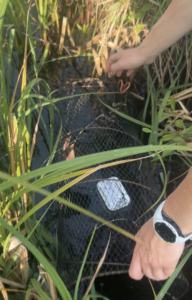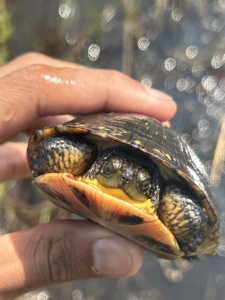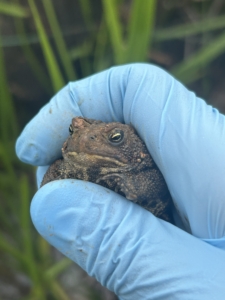You all know we find and sample turtles for research. But what does that actually mean?? Today, we’ll go through a step by step of exactly how our process works. And there’s going to be turtle pictures if you weren’t already going to keep reading.
First of all, we catch turtles two main ways, at least in Lake County – traps and telemetry. Telemetry means we attach a tracker to their shell, and we can use radio tracking devices to find them week to week. The other method we use is setting hoop traps in various locations through the sites. We bait these traps with the stinkiest sardines to ever exist, which lures the turtles, and check them daily.

Once we have one of our lovely Blanding’s in our GLOVED hand, we need to figure out who it is. Each turtle gets a unique “notch code,” small indents in their shell that help us identify who is who! Many of them also have microchips, just like your dog or cat. Blanding’s almost never bite, but sometimes you get a mean one – they say if you get bit by a Blanding’s, it’s 10 years of bad luck. See below for the lil gal that potentially just ruined the next decade for me:
We try to draw blood right away so the stress of capture plays a minimal role on our blood test results. We can then move onto our physical exam – we’ll look at their eyes, in their mouth, their shell condition, limbs, etc., and record any abnormalities. Anything weird we see could be a number of things, which is where our work back at the lab will come in. At the end, we get swabs! We swab their mouths and shells, which we can use PCR on to test for tons of different diseases. One of these days we’ll go over what sort of bloodwork we run at the lab, but i’m tired so let’s move onto…
Frog of the Week!!!
This American Toad was found in a hoop trap just a few days ago. We’re not sampling any toads this summer, but he just looks so grumpy! Enjoy my new best friend below.

